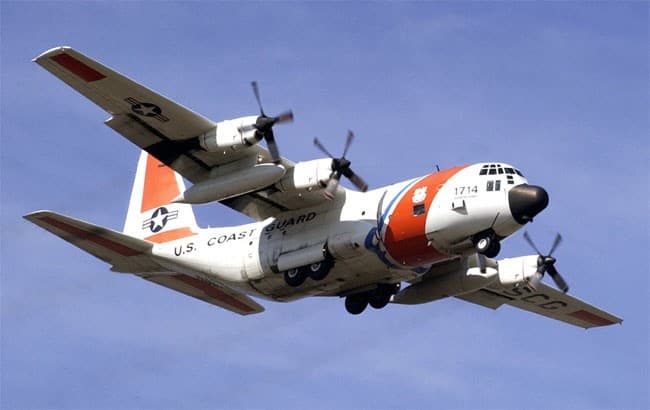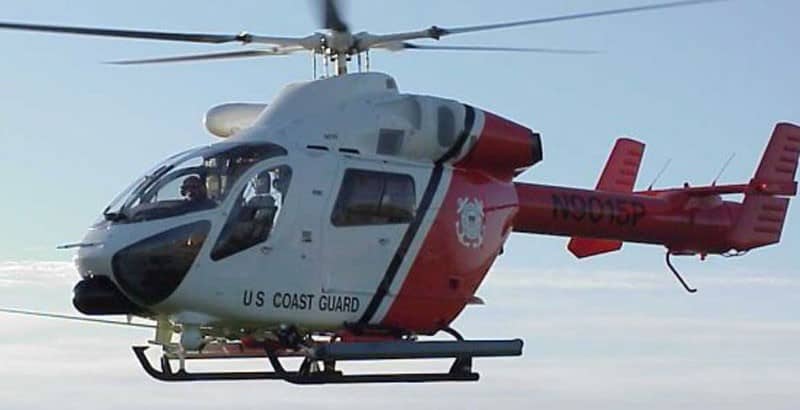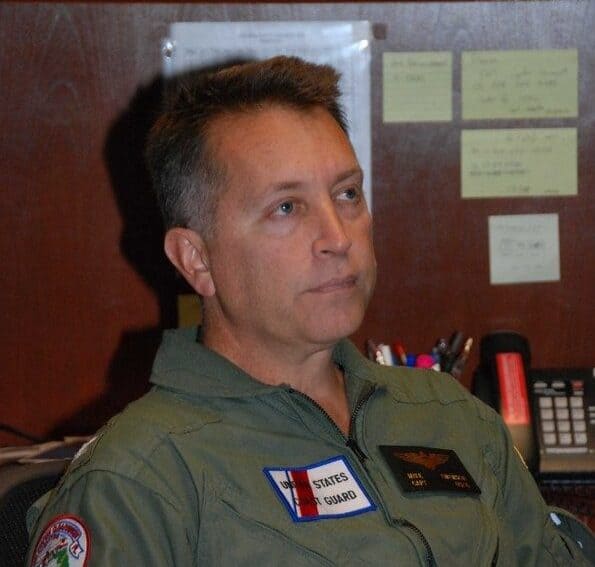A legacy is what someone leaves behind for others. Heritage is what one receives that’s come down to him from the past. Mike, born in Norfolk Virginia in 1962 was the eldest son of a Coast Guard Chief Petty Officer whose father served in the US Lighthouse Service. He graduated from the United States Coast Guard Academy, as a Commissioned Coast Guard Officer in 1984.
Mike’s first duty assignment was the Coast Guard Cutter Cherokee, WMEC 165, based out of Little Creek. Virginia. She was launched as the USS Cherokee (AT), a US Navy Fleet tug in 1939. She served with distinction during WWII. On 29 June 1946 the Cherokee was transferred to the US Coast Guard. Designated the USCGC Cherokee (WAT-165). In 1965 the designation was changed to Medium Endurance Cutter, (WMEC-165). She was 205 feet long with a speed of 16 knots and was armed with a 3-inch gun. In 1984, her primary duty was maritime drug interdiction.

But to back up a moment; the start of maritime drug smuggling was prompted by a demand for marijuana in America that could not be met by the land supply from Mexico. Marijuana smuggling changed dramatically in the mid-seventies. In 1975 the Mexican government agreed to an aerial drug crop eradication program using the herbicide 2-4-D. The primary goal was to spray the poppy fields to reduce opium production but was spread to marijuana resulting in a “poisoned’ supply. The Marimbas, as they called themselves, of Colombia’s North Shore, who had been in various smuggling operations for years, stepped into the void. In order to meet demand, a substantial capacity increase, best provided by maritime transportation, was needed. The Marimberos expanded their operation from production and packaging to include transportation and distribution.
The Coast Guard developed an interdiction system whereby existing assets could be concentrated to intercept a transporting vessel prior to it reaching its destination. In order for a vessel, leaving the La Guajira Peninsula on the north coast of Colombia, to reach drop-off areas adjacent to the United States, they had to transit one of four passages through the islands of the Caribbean. These passages were referred to as choke points. Cutters took up station at a choke point.
Mike was the boarding officer during his time aboard the CGC Cherokee. During this period, 1984-1986, there were 50 plus boardings conducted, including three large drug seizures and 17 arrests. The seizure of the MV Arikok yielded 23 tons of marijuana.

In 1986 Mike was transferred to the Coast Guard Cutter Vashon WPB 1308, commissioned at New Orleans and Home Ported in Roosevelt Roads Puerto Rico. Mike was the Executive Officer. Drug interdiction and migrant interdiction were the primary duties.
In 1988 Mike was on his way to flight school, Initially Pensacola, Florida then to NAS Corpus Christi, TX., followed by C-130 qualification at Little Rock Air Force Base, at Little Rock Arkansas.
His first Aviation Duty station was Coast Guard Air Station (CGAS) Borinquen, Puerto Rico. Air Station Borinquen is a direct descendant of Air Station San Juan, which was located on the Isla Grande Naval Station. In November 1971, the Air Station relocated to its present location at what was then Ramey Air Force Base in Aguadilla. The Coast Guard assumed the host role in July of 1976 when the Navy vacated the station. It was then that this unit was designated Coast Guard Air Station Borinquen. The name is derived from the Taino Indian name for the island of Puerto Rico.
Aviation expanded and missions and utilization varied during the ensuing years. The Air Station originally utilized three HU-16 Albatross aircraft and two HH-52A helicopters to carry out search and rescue missions. Three HH-3F helicopters replaced these aircraft in March of 1973. The need for a long-range law enforcement reconnaissance aircraft resulted in the addition of three HU-25A Falcon jets to the Air Station’s inventory in late 1983 and early 1984. The HU-25A Falcon Jets were replaced by the HC-130H Hercules in 1987.
The primary mission, search and rescue, is but one facet of the multi-mission responsibilities. Of special note was the unit’s significant response to the devastation left by Hurricanes in the Caribbean. Other duties include support for aids to navigation, surveillance for illicit drug traffic, air interdiction of drug trafficking, patrolling of the 200-mile fisheries conservation zone, and marine environmental protection. The aircraft assigned changed with the mission.

Mike transferred to CGAS Barbers Point, Hawaii in July of 1992. While there, he successfully coordinated humanitarian relief efforts in the wake of Hurricane Iniki. He participated in 60 Rescue missions, executed a high visibility interdiction of 537 illegal immigrants aboard the M/V EASTWOOD and the seizure of the South Korean F/V HAENG BOX #309 and its 300 ton catch of tuna. The vessel had been illegally fishing within Exclusive Economic Zones in the Pacific Ocean.
Mike attended the United States Marine Corps Command and Staff College in 1995. The Marine Corps Command and Staff College provides graduate level education and training to develop critical thinkers, innovative problem solvers, and ethical leaders to serve as commanders and staff officers in service, joint, interagency, intergovernmental, and multinational organizations. The Command and Staff College is a ten-month program on national security issues. He obtained a Master’s Degree in Military Studies.
During the period 1996-2000. Mike was assigned to the US Coast Guard Office of Law Enforcement, becoming Chief of the Drug Interdiction Division. General Barry McCaffery was confirmed by the US Senate on February 29, 1996 as director of the Office of National Drug Control Policy (ONDCP), a Cabinet Position. McCaffrey came to this position with experience with drug interdiction as head of the Southern Command. Mike prepared a brief on Coast Guard Operations in the Caribbean given to General McCaffery. It was very effective and considered outstanding by VADM James Loy who was Chief of Staff at the time.
Admiral James M. Loy, Commandant of the Coast Guard and U.S. Interdiction Coordinator for counterdrug operations, wished to evaluate the possible use of force by Coast Guard helicopters for interdiction purposes. He had considerable support from the ONDCP, a number of Congressional officials, and after extensive discussion between legal and operational staffs, the Attorney General, Janet Reno signed off on the proposal. Within the Coast Guard, however, there were almost as many critics as supporters. There were those that felt that to arm ourselves would place the helicopter crews in danger and undermine our lifesaving and humanitarian image. There had been an erosion of the military culture within the Coast Guard that was accelerated after transfer to the Department of Transportation. Those in favor of airborne use of force recognized that the Coast Guard was charged with a law enforcement mission and that the proposed policy change was an operational necessity. Special training and safety procedures were advocated.
Commandant Loy directed that a “proof of concept” operation using armed Coast Guard helicopters to interdict and apprehend “go-fasts” be conducted. Mike Emerson was assigned as project Officer.
Two concepts were tested:
- The use of armed helicopters;
- The use of high speed over-the-horizon pursuit boats (OTH) which worked in concert with the armed helicopters. These boats were “souped-up” versions of the Coast Guard’s standard rigid-hull inflatable boats. The OTH boats differed in that they are equipped with twin inboard/outboard turbocharged diesel engines, onboard radar and navigational systems for over the horizon operations. The OTH’s were capable of 57 knots.

This gave rise to the beginnings of a helicopter interdiction force. Commander Mark Torres molded an initial group of ten volunteers into a cohesive and effective team. The group, named HITRON-10, pioneered novel and effective operating tactics and procedures. HITRON was the acronym for Helicopter Interdiction Tactical Squadron and 10 represented the number of initial crewmembers assigned. The team flew leased MH-90 enforcer helicopters The MH-90, a militarized version of the MD 900 helicopters built by MD Helicopters Incorporated, was an all-weather, short range, single rotor, shipboard helicopter. It was powered by a Pratt & Whitney 206D turboshaft engine and designed without a tail rotor. It could cruise at 120 knots for 2.5 hours. The 6,500-pound helicopter was equipped with weather radar, an Mk III forward-looking infrared system (with video-recording capability), night-vision devices, an external sling capable of lifting 1,500 pounds, and a rescue hoist capable of lifting 600 pounds. The crew consisted of two pilots and one crewman. The crewman’s principal duties included firing an M240G 7.62mm machine gun (swivel-mounted at the portside cabin door) and/or a hand-held laser-sighted .50-caliber rifle. He also operated hand-held video and photographic equipment.
A variety of non-lethal devices and technologies were tested such as “sting ball” grenades which produce a loud explosion and bright flash and showered their victims with tiny pellets of rubber that caused pain but did not penetrate the skin. Mike and his colleagues at the R&D Center also tested mal-oderants, pepper spray, and 40mm “foam batons” fired from an M203 Grenade launcher. To physically stop a boat, it was planned to use entanglement nets to foul the propellers of the “go-fast” boats but they had little effect. By far, what proved most effective was to use the M240G machine gun to fire warning shots across the bow after which, if the “go-fast” did not stop, the .50 caliber rifle was used to disable the boat’s engines.
Before Operation NEW FRONTIER, according to the service’s own statistics, the Coast Guard had about a one-in-ten chance of stopping a “go-fast.” During the evaluation operations, the Coast Guard scored a perfect “six of six” in pursuits and apprehensions.
Admiral Loy credited the Coast Guard’s bold tactics, introduced in Operation NEW FRONTIER with intercepting 53 tons of drugs, including a record amount of cocaine. By all measures, the operation was a major success.
In March 2000, the Coast Guard completed its proof-of-concept efforts and started the process of standing up a fully operational HITRON squadron. Soon thereafter, Coast Guard pilots, aircrews, and support personnel began reporting to Cecil Field in Jacksonville, Florida, where the new unit would be headquartered.
As a follow-up to Operation NEW FRONTIER, and to bring HITRON-10 to full operational capability, the Coast Guard formed a strategic alliance with Agusta Aerospace Corporation in April 2000 and in March 2001 announced that it would lease up to eight Agusta A109E “Power” aircraft to serve as follow-on aircraft for the proof-of-concept MH-90.
In 2000 Mike was back to Barbers Point where he served as Operations Officer and then was transferred to CGAS Clearwater as the Executive Officer in 2004. He fleeted up to Commanding Officer within a year.
On August 29 2005, Hurricane Katrina, a large Category 5 Hurricane struck the Gulf Coast, primarily in southeast Louisiana and the Gulf coasts of Mississippi and Alabama, causing over 1800 deaths and $125 billion in damages. New Orleans was hit hardest, with eighty percent of the City and surrounding Parishes inundated with water. Transportation and communication facilities were almost non-existent. Thousands of people were stranded without food and water. The scale of the disaster provoked a massive national response. Coast Guard Air Station New Orleans, commanded by CAPT Bruce Jones was 8 miles south of the City, and although suffering severe damage, immediately responded. ATC Mobile, CAPT Dave Callahan Commanding was responsible for the Mississippi and Alabama coastal areas and supplemented CGAS New Orleans. CGAS Clearwater, CAPT Mike Emerson Commanding, was responsible for Coast Guard logistics support.
Coast Guard Air Station Clearwater was the hub for Coast Guard C-130 operations. The operations continued throughout Hurricane Katrina and rolled right into support for Hurricane Rita which followed. Five Clearwater C-130s were supplemented by C-130s from the Aircraft Repair and Supply Center and the Elizabeth City, Sacramento, and Kodiak Air Stations. What followed was amazing. Coast Guard Aviation is pro-active and dedicated to the saving of life. When in a crisis and lives are at stake there is no problem “throwing rules out the window’ and doing whatever it takes to get the job done, and get permission later. In many instances this is exactly what CAPT Mike Emerson and the dedicated personnel under his Command, did.
Then CDR Rich Paglialonga dispatched over 100 aircrew and support staff, including YN, SK, and HS members, to augment Airstas NOLA and Mobile. Meanwhile, CDR Jack Vogt led a deployment crew of rotary wing maintainers to establish an assembly line for helicopter maintenance and test flights that expedited returning helos to service during critical rescue periods. LCDR Eric Riepe, with able assistance, scheduled the C-130 operations. A support plan, often using immediate feedback from returning sorties, was developed. LCDR Bruce Brown was comptroller and arranged for procurement of supplies and needed materials. The telephone and at times a credit card was the primary means of procurement – back-up paperwork followed when time permitted. Coordination was maintained with the Maintenance Department so that the aircraft configurations were correct for the scheduled loads. Regular reports on operations were provided to LANTAREA (C-130s were Area assets), to provide them visibility on what was taking place.
Prior to Katrina making landfall an inventory of ready migrant interdiction supplies at CGAS Clearwater, which included food, diapers, lifejackets and more was completed. Once Katrina made landfall, the overwhelming need for not only relief supplies but supplies for first responders was recognized. The supply warehouse and hangar were delivery points for consumables. Contracts with multiple vendors in the Central/South Florida area were secured to buy bottled water by the pallet. Based upon lift capacity arrangements for delivery of up to 20 pallets per day was made and loaded directly onto waiting aircraft. Likewise, thousands of MREs were procured and delivered as were blankets, diapers and other personal items. Working with a network of local churches, donations of consumables ranging from five to seven truck loads a day were received in Supply, re-packaged for air transport and loaded. In addition, first responder items including heavy equipment such as forklifts, ground handling equipment and generators were flown to CGAS New Orleans and ATC Mobile.
Toward the end of the week, when the Incident Management Teams (IMT) established a footing, coordinated efforts began and often the supply schedule was rolled into an IMT requirement. It was just shy of four weeks -post Katrina- before FEMA supply lines were established to the point where Coast Guard procured/donated and delivered supplies were no longer required. The breadth of the C-130 operation and the multiple capabilities of the C-130 was demonstrated in that in addition to relief supplies the C-130s served as communications platforms, conducted surveillance missions, transported DART teams, MSST units, fuel cells, medical personnel and supplies, evacuated stretcher patients out of the area to receiving hospitals, and even 100 buoys were flown in from CGD9 for use by Sector Mobile.
Senator Collins, during a Congressional Hearing, following Katrina, made the following statement. “Amidst a sea of failures across all levels of government, the Coast Guard stands out as a shining example of a mission accomplished through careful planning and outstanding execution. We must learn from the failures that this investigation has revealed, but we must also learn from its successes. The Coast Guard’s extraordinary performance provides models for other agencies in all levels of government to emulate”
Mike was Chief of Aviation Forces 2007-2011. During this period; Requirements for helicopter detachments on board the new Cutters that were being constructed were developed. Airborne use of Force capabilities were transitioned to the HH-65 helicopter. The Rotary Wing Intercept capability was established in the National Capital region. In addition, Mike was assigned as the Director, Aviation Coordination Command at Tyndall Air Force Base, during the Deepwater Horizon explosion and oil leak. The oil rig, located in the Gulf of Mexico was 41 miles off the Louisiana Coast. This was the largest oil spill in history and did immense environmental damage. Mike astutely recognized that an aircraft mishap would overshadow any successes during the spill response, and leveraged FAA authorities to establish a Special Terminal Flight Region to safely manage airspace over the spill.
During 2011-2012, Mike represented the Coast Guard on the CNO Strategic Study group in Newprot, RI. Mike was the Senior Fellow of 12 officers and led development of innovative concepts to employ electromagnetic capabilities. He served his twilight tour from 2012-2014 at the Department of Homeland Security, in the Office of Operations Coordination and Planning.Mike retired as an O6 in 2014 after 30 years of service.
Mike returned to the Coast Guard as a civilian in August of 2015. He is now the Director for Marine Transportation Systems and Senior Arctic Policy Advisor at Coast Guard Headquarters. He manages a broad portfolio of marine navigation, waterway, and bridge programs, and is also responsible for a wide variety of Polar and Arctic safety and security initiatives.
Mike worked extensively with the Coast Guard Aviation Association, known as the Pterodactyls, when he was Chief of Aviation Forces. In 2018 he became President of the Association and has led the expansion and increased involvement in matters pertaining to Coast Guard Aviation Association.
Coast Guard Aviation Association
John Moseley




